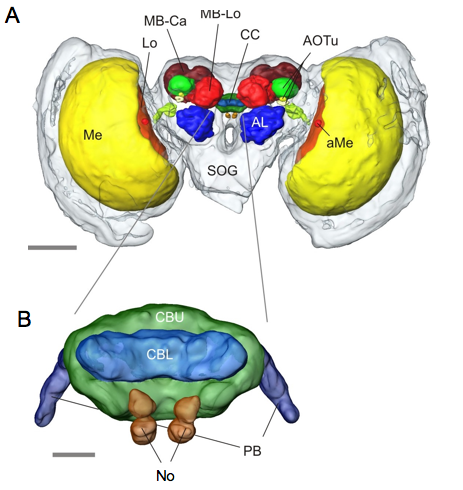The Central Complex
Based on studies in other insects, it appears that the sun compass component of the time-compensated sun compass process resides in the central complex. The central complex is a midline structure in the insect brain consisting of the protocerebral bridge, the upper and lower division of the central body, and the noduli.
Recent electrophysiological studies in locusts and crickets have shown that the central complex is the actual site of the sun compass for skylight E-vector integration from both eyes, and probably for all skylight information. For example, in locusts, the columnar organization of cells in the protocerebral bridge of the central complex provides a topographical map of overhead polarized skylight patterns (Heinze and Homberg, 2007). The sky's pattern of E-vectors correlates with the position of the sun, so this capability provides a means to code for directional information.
We have recently described the anatomical layout of those aspects of the butterfly's central complex likely to establish part of the internal sun compass and analyzed the function of the neurons found in these regions (Heinze and Reppert, 2011). This video highlights the major findings of our initial study of the monarch’s sun compass system. A summary of the major findings is discussed below:
Using synaptic markers, we constructed three-dimensional representations of the entire monarch brain, as well as individual regions known to be important for sun compass navigation, based on those established in the well-studies desert locust. Injections of fluorescent dyes allowed us to trace single neurons and characterize the neuronal composition of the butterfly sun compass. Remarkably, the neuron types found in the monarch butterfly could be matched with all of the homologous counterparts present in the sun compass of the locust.
Three-dimensional organization of the Adult Monarch Brain and Central Complex
 Heinze & Reppert
Heinze & Reppert
A, Frontal view of a three-dimensional reconstruction of the major brain neuropils, based on confocal image stacks (scanned with 10x objective) obtained from anti-synapsin stained wholemount preparations (voxel size:3µm³). Shown in grey is the surface of the brain. B, Frontal view of the same reconstruction as shown in A. Three dimensional reconstruction of the main central complex components, based on confocal image stacks (scanned with 25x objective) obtained from anti-synapsin stained wholemount preparations (voxelsize: 1µm³). AOTu, anterior optic tubercle; aMe, accessory Medulla; AL, antennal lobe; CC, central complex; CBU, upper division of the central body; CBL, lower division of the central body; Me, medulla; Lo, lobula; LoP, lobula plate; MB-Ca, calyx of the mushroom body; MB-Lo, lobes of the mushroom body; No, noduli; PB, protocerebral bridge; SOG, suboesophagel ganglion; scale bars represent 500µm (A) or 50 µm (B).
To determine the function of input neurons to the monarch central complex, electrodes were inserted into these cells and their activity recorded while the animal was confronted with individual skylight features. All neurons that were part of the proposed monarch sun compass network responded to simulated skylight features with specific changes in their action potential frequency. Remarkably, two very different stimuli were processed in individual cells - polarized light from directly above the animal, and unpolarized light spots, which were rotated around the horizon. In response to polarized light, each cell encoded a particular angle of polarization. Additionally, these neurons also showed strong excitation when an unpolarized light spot (likely interpreted as the sun) was present in a particular direction relatively to the butterfly. Occluding different parts of the eye revealed that both stimuli are perceived independently through separate pathways and the information then converges onto single compass neurons.
To provide a reliable orientation signal, the solar position indicated by polarized light must match the actual solar position of the sun itself; in this way, polarized skylight can provide the proper directional information when the sun is obscured by clouds. However, the angle of polarization is linked to the solar position in a rather complicated way and this relation changes over the course of the day. Thus, to provide consistent information, the polarized light pattern must be compensated by adjusting the response properties of the neurons over the day. Interestingly, this is exactly what the monarch sun compass neurons appear to do. These findings are reminiscent of a similar mechanism that is present in the locust and suggest that forming a consistent neural representation of ambiguous skylight compass cues in the brain is an essential feature of migratory insects.